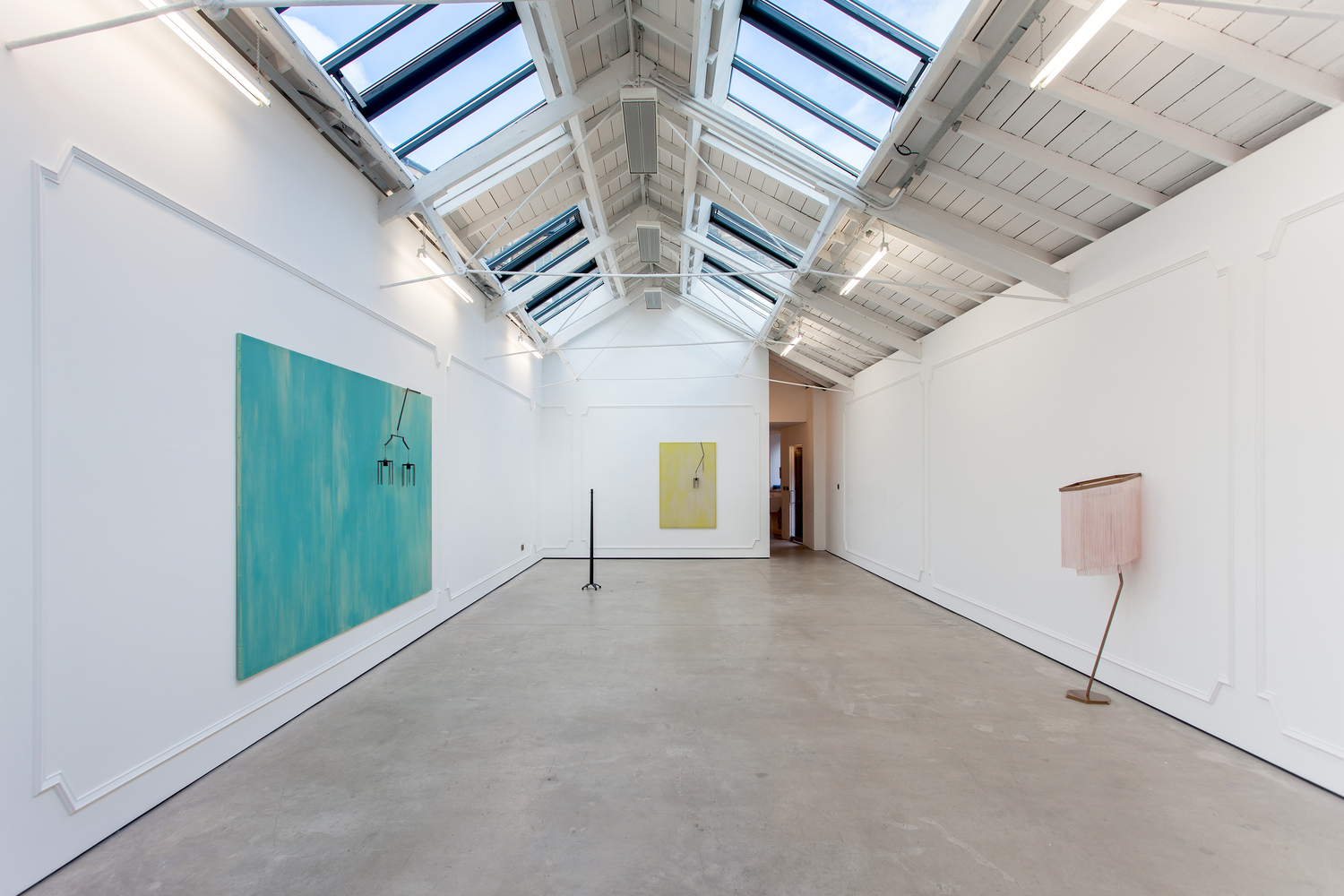Martin Boyce ‘Light Years’

‘Light Years’ marks the 5th solo exhibition by Martin Boyce at The Modern Institute, presenting a new body of work encompassing installation, sculpture, and painting. Restaging the gallery’s Osborne Street space as a grand domestic landscape, Boyce explores a range of familiar references and forms to construct environments and sculptures that embody a poetic ambience and over time produce an ongoing constellation of connected works.
Along the main gallery’s walls, Boyce has installed decorative wall moulding to create a series of large frames reminiscent of archetypal bourgeois apartment interiors. A new series of paintings, framed by the decorative moulding, is likened by Boyce to industrial colourfield landscapes. Using industrial paint on perforated steel panels, Boyce applies a standardised RAL colour on each and builds the paint up in thin washes. In turn, the surface assumes a sun-faded, subdued appearance. The washes and streaks recall stained antique silk paneling while the perforated surface alludes to half tone printing techniques and mass productions – a form of industrialised exoticism. Boyce has cited Monet’s waterlilies and Ma Yuan’s sea and landscape painting as a reference point for this new series.
On each painting, Boyce has positioned sculptural elements such as metal armatures from which chain lanterns hang. These sculptural forms could also find their source in nature whereby a metal arm becomes a tree branch and a lantern a flower. These isolated elements relate to the ‘one-corner’ compositions characteristic of Ma Yuan — aligning the actual subject of the painting to one side or corner, whilst leaving the rest of the surface mostly uninhabited. The armatures and their connection to natural forms further identify with the personal style developed by Ma Yuan, with its marked decorative elements and depictions of pine trees, described in appearance as ‘strong as if they were made of iron.’
Throughout the gallery space, Boyce has positioned several standing sculptural works all of which take the form of standard lamps – a continuation of his ‘Dead Star’ series, with each assuming a figurative presence and individual character. Drawing on cinema, the exhibition could be seen to recall a cocktail party from an Antonioni or Fellini film, populated by sophisticated yet disaffected guests. Separating itself from the grouping, one brass piece with a faded-pink fringed lampshade gently leans against the wall as if tired of the scene. The series also acknowledges the works of the brothers Diego and Alberto Giacometti – the standing lamps physical presence, as well as their air of isolation, share a connection with Alberto Giacometti’s tall, gaunt bronze figures, while the influence of Diego Giacometti’s furniture, in particular his lamps, is evident in the form of Boyce’s sculptures.
Each of the sculptures’ light fittings has been cast in bronze, creating a condition whereby the lamps can never be in a state of illumination, devoid of their function — essentially rendering them ‘Dead Stars’, ghostly and hollowed out. Heightening the sense of disconnect and seclusion, each piece includes a corresponding bronze cast plug socket or light switch — further indicators of their the objects’ purpose unfulfilled.
Within Boyce’s body of work is an interest in landscape, the psychology of interiors, of architecture and furniture – in how, through the collecting of design objects, the mantra of form and function transfers its weight towards form and value. The ‘Dead Star’ series quietly contemplates this condition – with their purpose shifted away from a practical item that gives light to a sculptural object that occupies space and time, the lamps amass a weight of imaginary histories and poetic possibilities.
Martin Boyce (b. Hamilton, Scotland in 1967; lives and works in Glasgow). Boyce has been the subject of numerous solo exhibitions internationally, with select exhibitions including: ‘Sleep Chimneys. Dead Stars’, Tanya Bonakdar Gallery, New York (2017); ‘Inside rooms drift in and out of sleep / While on the roof / An alphabet of aerials / Search for a language’, Galerie Eva Presenhuber, Zurich (2015); ‘Martin Boyce: When Now is Night’, RISD Museum, Providence (2015); Museum fur Gegenwartskunst, Basel (2015); ‘All Over / Again / and Again’, The Modern Institute, Aird’s Lane, Glasgow (2013); ‘Out of This Sun, Into This Shadow’, Ikon Gallery, Birmingham (2008); ‘Electric Trees and Telephone Booth Conversations’, FRAC des Pays de la Loire, Carquefou, France (2007); ‘For 1959 Capital Avenue’, Museum für Moderne Kunst, Frankfurt (2002); and ‘Our Love is Like the Flowers, the Rain, the Sea and the Hours’, Tramway, Glasgow (2002). Boyce represented Scotland at the 53rd Venice Biennale (2009).
Boyce was the recipient of the 2011 Turner Prize exhibited at The Baltic Centre of Contemporary Arts, Gateshead, and his prize-winning installation ‘Do Words Have Voices’ has recently been on view at Tate Britain as part of the BP Spotlight series.









